The Ultimate Guide To SEO Copywriting in 2022 


Copywriting is a necessity for any business that wants to get discovered online.
B2B, eCommerce, finance, travel — it doesn’t matter what industry you’re in. Your copywriting game is what’s going to help you outrank the competition in Google search and drive more online visitors to your website to convert.
Get this right, and the rest of your online marketing will fall into place like clockwork.
It’s no wonder that 61% of marketers say improving SEO and growing organic presence is a top inbound marketing priority.
The challenge is this: Google’s algorithm is now so insanely fine-tuned that it can spot poorly written copy from a mile away.
That’s where your SEO copywriting comes into play.
The most effective copywriting is written for humans, then optimised for search engines.
That’s how you can make sure your web pages rank for the right search terms to reach the right audience and compel them to act.
Not sure where to start? Don’t worry — you’re in the right place. With this handy guide to SEO copywriting in 2022, you’ll have everything you need to get discovered online. We’ll cover:
- What is SEO copywriting and why is it important?
- Important copywriting elements for SEO
- Must-know SEO copywriting tips
- SEO copywriting don’ts in 2022
What is SEO copywriting?
SEO copywriting is the process of creating useful content that solves a user’s search intent and that is easily discovered by Google.
Good SEO copywriting has two goals.
The first is to provide value to your users and prompt them to take action. This could be buying a product, subscribing to a list, submitting a request form, or any other activity that encourages them to move further along the customer journey.
The second is to increase your website’s visibility in Google’s organic search results.
SEO copywriting is formatted in a way to makes it easy for search engines to understand what your content is about, so it’s more likely to appear for relevant user searches. Well-researched and informative SEO copywriting also increases the authority of your website online, which is another crucial factor for improving your ranking in search engine results pages.
These two are inextricably linked.
Create good content that isn’t optimised for SEO, and a good portion of your audience won’t discover your business online.
Create SEO-focused content that isn’t optimised for your users, and you’ll get outranked by competitors who are doing a better job.
That’s why the most effective way to amplify your online presence among your target audience in 2022 is to solve their problems with well-crafted and well-optimised content.
Why is copywriting important?
To understand why copywriting is important for SEO, we first need to get to the root of Google’s goals as a search engine.
Google wants to deliver high-quality and high-relevance answers for any query. It judges this by more than 200 ranking factors, from the inclusion of the target keyword to social shares and the amount of time users spend on a website.
Now let’s look at copywriting.
The best copywriting isn’t just about stringing words together — it’s about persuading users to take an action. When you provide value to your users time in and time out, they’ll gradually move through your customer funnel and convert, whether that’s through signing up for a newsletter, booking in a demo or buying a product.
Convince enough people to take action, and Google will see your content as valuable to your audience and push you higher in search engine results pages. And this is precisely where you want to be, because 3 in 4 people never scroll past the first page of search engines.
Copywriting comes in many different formats, but the most common digital formats include:
Blog post
Blog posts explore different topics that are relevant to a website’s industry or operations. These might be articles, listicles, round-ups, interviews or opinion posts.
Blogging is one of the most popular content marketing strategies out there for SEO. In fact, adding a blog to your website can increase your chances of ranking in search results by as much as 434%.
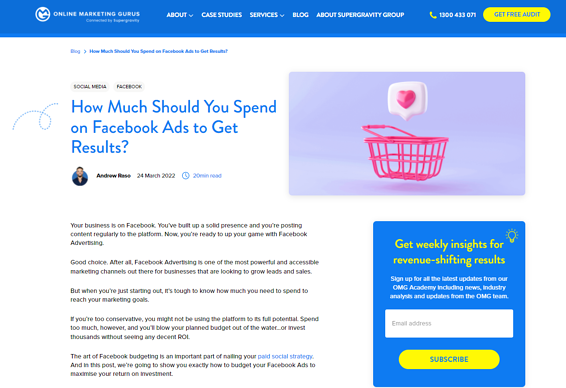
Landing pages
These pages sit on your website and provide your audience with valuable information on your brand, products and services. Common landing pages include an “About” page, “Services” page, or a campaign-specific page for a promotion.
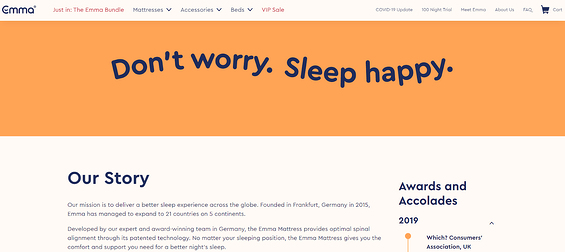
Ebooks
eBooks are long-form pieces of content that are usually available as a digital download. You’ll typically find eBooks used as a lead magnet, encouraging audiences to provide their details in exchange for a free copy.
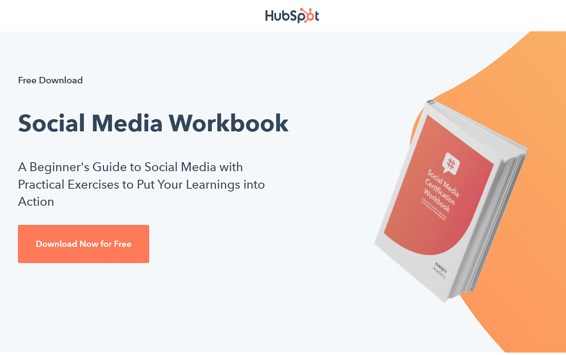
Ad copy
Copywriting is an integral part of any effective online advertising campaign. You’ll find powerful copy on display ads like this one from Apple:
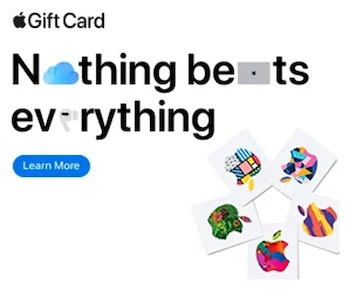
Or on paid search ads like Upwork:
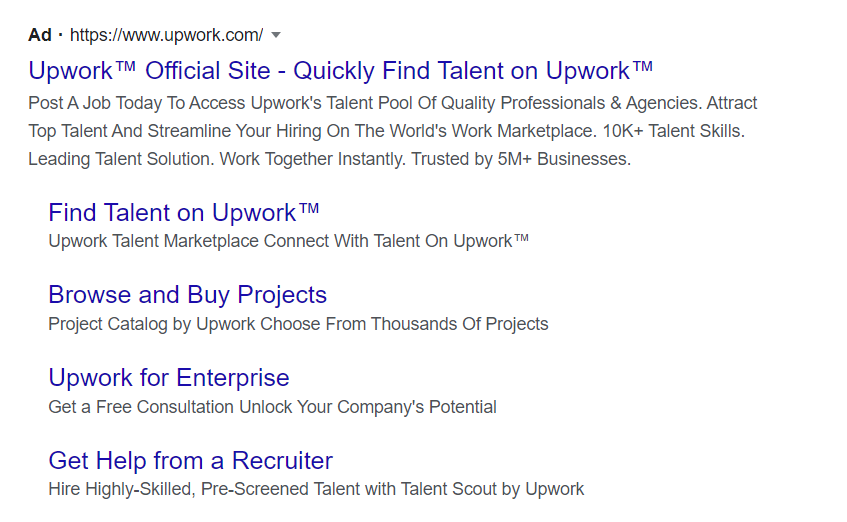
Website content
On top of landing pages, copywriting is used throughout a website to inspire users to take action. Examples include product descriptions or step-by-step instructions for signing up for a subscription box, similar to this one from Good Pair Days:
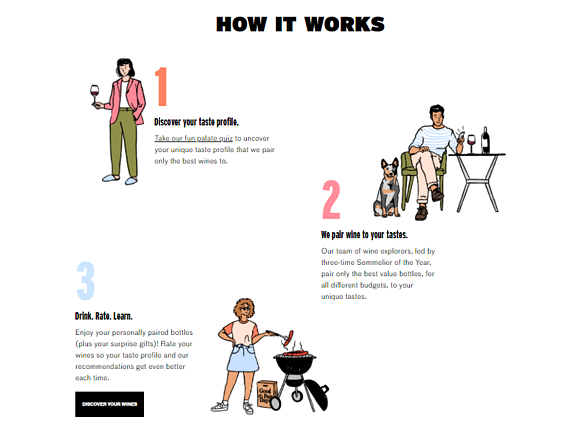
Important elements for SEO copywriting
Here’s the good news.
You don’t need to be a technical expert to craft copy that’s created for humans and optimised search engines. However, there are a few basics that, when used correctly, will help increase your discoverability in search and increase your website’s conversion rate.
When you’re writing content for your website, make sure you keep these six elements in mind.
Site speed
The first important element of SEO copywriting isn’t writing at all. It’s your web design.
Consider this: the probability of a user bouncing from a website increases by 32% as a page’s load time goes from 1 second to 3 seconds. With every additional second of load time, website conversion rates also drop an average of 4.42% (between 0 and 5 seconds).
If your content doesn’t load quickly, what you’ve written won’t matter. Site speed is also a crucial ranking factor in Google search results, particularly with the launch of its new Core Web Vitals update in 2021.
That’s why you need to optimise your site speed to reap the maximum benefits of your SEO copywriting efforts and convert more SEO traffic.
Thankfully, it’s easy to measure your website’s load time with Google’s PageSpeed Insights tool. Just pop your URL in the field and hit “Analyze”:
The tool will then analyse your page’s site speed on both desktop and mobile devices. You’ll also receive a list of recommendations that you can follow to optimise your load times (and other Core Web Vitals).
Headline
Headlines are THE biggest influencing factor for someone clicking through to your website. According to Copyblogger, 8 in 10 website visitors will read your headline, while only 2 in 10 will read your actual content. If you want to increase your clickthrough rate, you need to develop headlines that draw readers in and prompt them to read the rest of your content.
There are a number of actions you can take to try and improve your headlines, based on a study from Conductor:
- Use a number. 36% of users prefer a headline with a number, such as “15 ways to be more productive at work” or “30 recipes that take less than 30 minutes”.
- Don’t go overboard with power words. Superlatives, such as “best” or “most”, can be effective in headlines, if used sparingly. Research shows that 51% prefer headlines with fewer superlatives, with 29% preferring 1 superlative and 22% preferring none.
- Be clear with your headlines. More than a third of all users prefer a headline that’s explicit and direct about the content in the article.
Another tip? Test out questions in your title tags to see what works with your audience. A study shows that question-based title tags have a 14% higher clickthrough rate compared to those without a question.
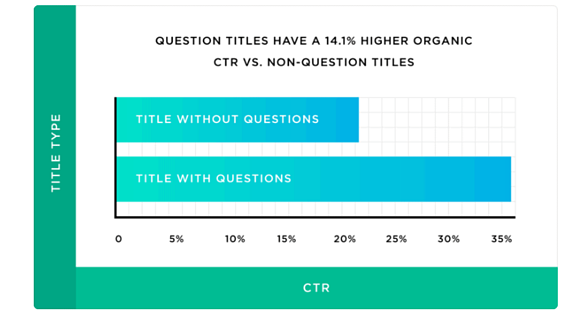
Image source: Backlinko
Content
Content is the biggest SEO copywriting element, and for good reason. People conduct Google searches to solve a problem — and your content needs to address that if you want to provide value to potential customers and rank highly in search results.
It all starts with an introduction that makes the reader want more.
If your headline has done its job, people will click through to read the rest of the piece. Now, you need to hook them in with an incredible intro.
As advertising expert Joseph Sugarman explains in The AdWeek Copywriting Handbook:
- The purpose of the first sentence is to get your reader to read the second sentence.
- The purpose of your second sentence is to get them to read the third.
- The purpose of the third sentence?
- You get the gist.
We love how Dropbox writes its intros. Look at this one for an article about decision fatigue:
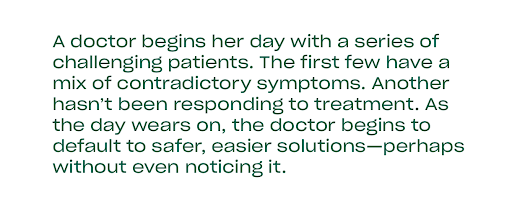
The introduction draws in the reader, making them want to read more, and more, and more.
If you can hook them in from the very beginning of your article, they’ll be more likely to read through to the end.
Do this, and you’ll increase time on page and engagement — both metrics that Google pays attention to when ranking your content.
Meta title and meta description
Your meta title and meta description are the two snippets that appear in Google’s search results. These two attributes help convey what your article is about to users and search engines, and entice people to click through to read more.
Here’s an example of a meta title and description from Time Out on the best things to do in Melbourne:
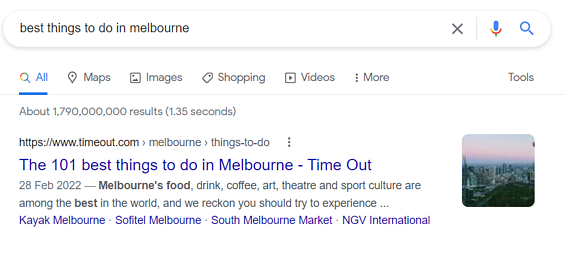
Search engine results only have a limited amount of real estate, so it’s important to keep your meta title between 50-60 characters and your meta description between 150-160 characters. Try to match your copy to the search intent, and include your particular keyword if applicable as these phrases will appear as bold text in search results.
Keyword frequency
Back in the day, SEOs used to stuff keywords in every part of their copy. This led to a whole lot of spammy web copy that was optimised for search engines and not for users.
These days, that kind of copy will get a website penalised by Google.
See, Google understands that people don’t write like this:
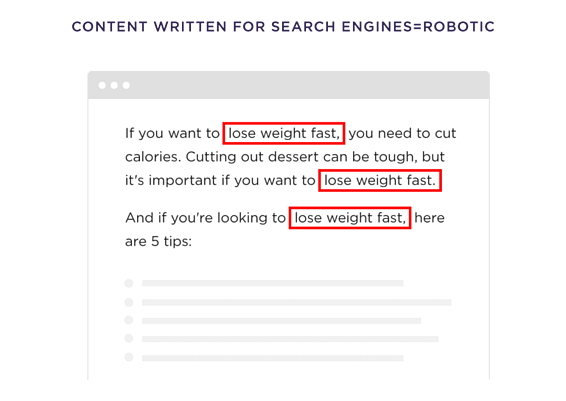
Image source: Backlinko
This isn’t to say that you shouldn’t include your target keywords at all in your copy. According to Google, keywords are still a fundamental part of the search engine algorithm:
You just need to be strategic about WHEN and HOW you incorporate them in your content.
Make sure your target keyword is in the most important places:
- Headline
- Introduction
- Title tag
- Image tag
- Meta descriptions
You should also incorporate long-tail keywords throughout your copy to target those low-competition search terms.
Another way to use keywords is with LSI keywords, which stands for Latent Semantic Indexing. LSI keywords are those keywords that are related to the main keyword that users search for.
Google relies on LSI keywords to understand content at a deeper level.
Let’s say you are writing a landing page about business loans.
Google will scan your page to see if you use the keyword “business loans” in your headline, title tags, content, etc.
But it will also scan to see if there are LSI keywords like finance, small business, funding, budget, and so on.
Page links
Links are an important way to build up your website’s ranking in Google search.
Here’s why.
If a website gets linked to from other high-quality websites, Google sees that website as being an authority in their field. And, given that Google wants to prioritise content that’s high-relevance and high-quality, it’s going to prioritise websites that are known experts in the arena.
It’s not just external links either. Internal links help Google crawl your website and discover all of your content, so it shows up in search engine results sooner.
Here are three steps you should follow if you want to use page links to improve your SEO copywriting and your rankings:
- Link to relevant pages within and outside your site in your introduction
- Weave links to more in-depth guides, website content on your page, or other sites throughout your copy
- Add a link to the appropriate anchor text. This should flow naturally through the copy and make sense within the context of the post.
11 must-know SEO copywriting tips in 2022
1. Work out your marketing funnel
SEO copywriting starts with the marketing funnel.
Marketing funnels map user intent to different stages of the buying process. It typically includes three stages:
- Top of Funnel (TOFU): Customers are unaware of your brand or product.
- Middle of the Funnel (MOFU): Customers know they need a product or solution, but may or may not be considering your brand.
- Bottom of the Funnel (BOFU): Customers are ready to make a purchase.
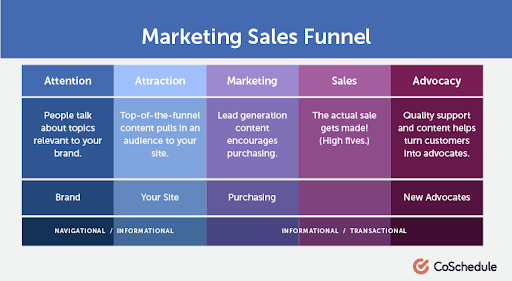
Image credit: CoSchedule
When you’re writing copy for your site, it’s critical to understand which stage you’re writing for. Does your audience know anything about the product? Are they at a stage where they’re comparing solutions and want detailed features and benefits?
Consider this content marketing statistic:
47% of B2B buyers view 3-5 pieces of content before engaging with a salesperson. — Demand Gen Report
Lots of content for SEO targets the top of the funnel – the stage where you’re building awareness of the problem and building trust with the audience.
But you need to equally focus on the bottom of the funnel content, such as landing pages, case studies and product descriptions.
Here’s a great example of bottom of the funnel content (case studies) by Marketo:

Another brand that does this brilliantly is outdoor adventure brand, REI:
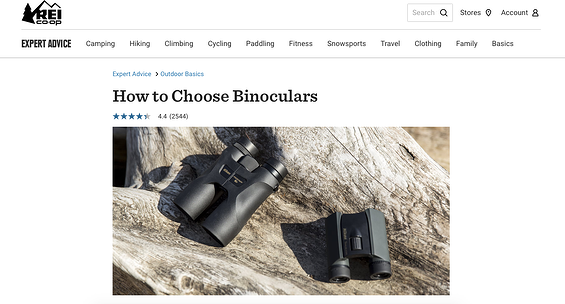
If you’re in the market for binoculars, this article provides all the information to help you make your decision:
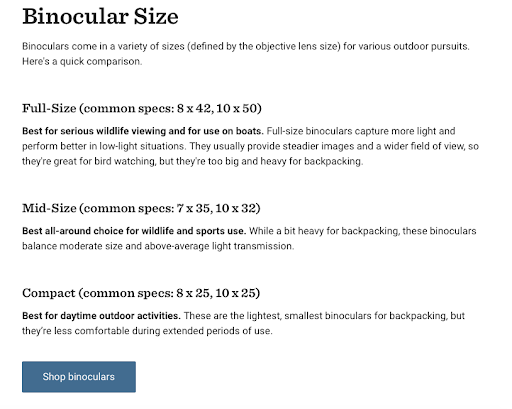
See the well-placed call to action button? This takes the reader directly through to the range of binoculars to make a purchase on their eCommerce site.
2. Get to know your target audience
All good SEO copywriting starts with the audience. How can you expect to engage your audience if you don’t know who you’re writing for?
Start by creating a buyer persona.
Think of this as a detailed description of a fictitious buyer – your perfect customer.
Use market research, data and sales information to find out information on your target audience.
It might look something like this:

Image credit: Single Grain
The more you know who you’re talking to and what their goals and pain points are, the more you can tune into these with your content.
Deloitte is a brilliant example of this in action. The company has a wide-scale audience, making it easy to be unfocused. So what did they do?
Create content microsites that focus on each buyer persona.
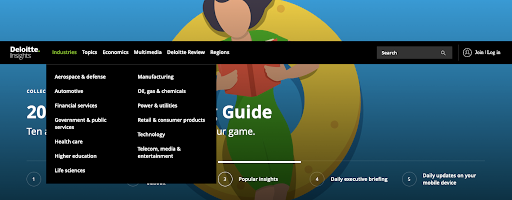
Knowing your audience can help you really speak their language and build your authority. For example, when you click on the Financial Services industry on the Deloitte Insights site, you see articles specifically targeted to your unique problems and challenges:
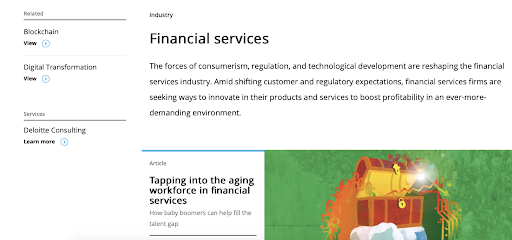
At the other end of the spectrum, check out how denim company Hiut Denim talks to its customers like they’re already friends:
We make jeans. That’s it. Nothing else. No distractions. Nothing to steal our focus. No kidding ourselves that we can be good at everything. No trying to conquer the whole world. We just do our best to conquer our bit of it. So each day we come in and make the best jeans we know how. Use the best quality denims. Cut them with an expert eye. And then let our ‘Grand Masters’ behind the sewing machines do the rest.
3. Nail your keyword research
Okay, so now you know your marketing funnel stage and your buyer persona. Bring it together to do keyword research.
Your keywords research is really the crux of your SEO copywriting.
With your funnel stage and buyer persona, you should be able to come up with a good starter list of terms (keywords) your buyers will be searching. The trick is to really get inside the heads of your audience. What would they search on Google?
Now, use these keyword research tools to help refine your list and find other relevant keywords, variations and combinations:
- Google Ads Keyword Planner: Don’t be put off by the words “ads”. This free tool provides valuable keyword insights for your SEO content.
- Moz Keyword Explorer: Use this tool to find heaps of information around search volume, related terms and more.
- Ahrefs Keywords Explorer: Similar to the Moz tool, Ahrefs provides awesome insights into keywords you should target.
Once you have your target keywords, it’s time to drill down into keyword intent.
Every search has an intention behind it. A user might be looking to conduct research into a product or service, or want to compare prices between the top brands. If you can answer that intent with your SEO copywriting, you’re well on your way to providing valuable content that users and search engines love.
Once you’ve identified the search intent behind each keyword, you can group them into categories based on a user’s likelihood of conversion.
This chart from Acquisio is a great example of where they classify their target keywords by low intent to purchase, medium intent, and high intent. The ones in the ‘high intent’ category are the best ones to prioritise for SEO copywriting and search marketing.
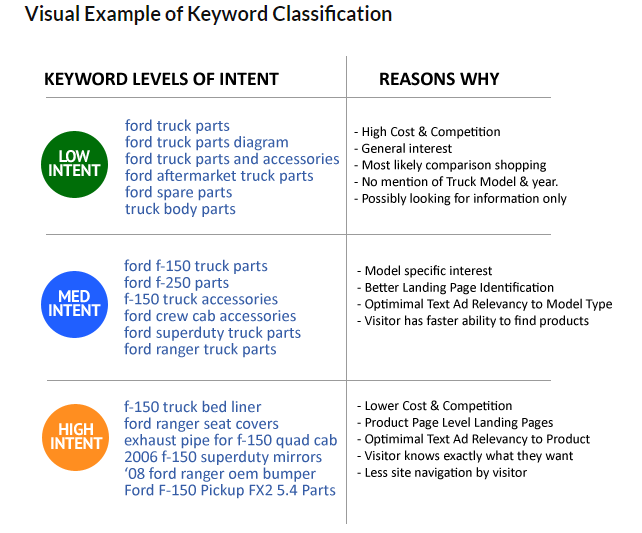
Image source: Acquisio
4. Plan your outline
That’s right – we’re still not at the actual writing stage. Your final planning step is to plan your outline.
It doesn’t matter whether it’s a blog post, case study or landing page copy, you need to take time to work out WHAT you are going to write and how it will FLOW.
Answer these questions:
- What’s the purpose of your article? What do you want to achieve with this piece? Go back to your marketing funnel to work out which stage you’re aligning with.
- What is the one key message you want to provide? What’s the one question you want to answer? That’s right, just focus on ONE. This will keep your piece focused and stop you from trying to get across too many messages.
- What structure are you using?
For the last question, our recommended structure to create content is the PAS, which is Problem / Agitate / Solve.
This classic formula is tried-and-tested. It gives you a solid template to keep your writing on track, while leading your readers through a story.
Here’s how it works:
First, identify the PROBLEM.
Take this example from bookkeeping software Xero. They have worked out that the problem small businesses need to solve is getting a start up loan. That’s the problem.

Next, AGITATE the anxiety and stress around that problem.
In the Xero example, they use this as the intro:
Do you need money to get a business idea off paper and into reality? Then you probably need a startup loan. But do they even exist? We answer your big questions about loans for new businesses.
Finally, offer a SOLUTION.
How does your product or service solve this problem for the audience?
The Xero article offers lots of tips to help solve the problem, which ultimately builds their authority in the finance niche:
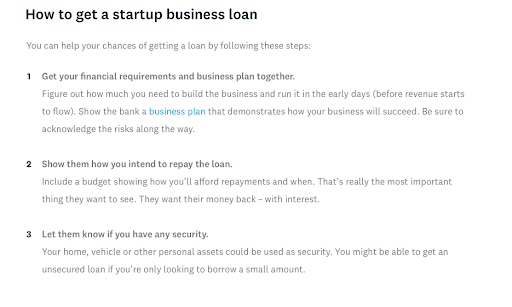
5. Build your structure to make it flow
Armed with your outline, go a step further and give your piece a structure.
Create a skeleton, including:
- Intro
- Main body
- Conclusion / Summary
Setting up the structure is essential to SEO copywriting. Google LOVES copywriting that has a clear structure.
Always, start with the most important content. Draw your readers in from the start, so even if this is the only part they read, they have the most important information.
6. Write for super scanners
People scan. They just do.
We’d love to share some incredible secrets to get people to read the whole piece…but most of the time, they just won’t.
Research shows that:
A user will only read 20% of the content on your page. — NNGroup
Only 20%.
So, stop fighting it.
Instead, make it easy for users to scan and get to the main points faster.
How?
Here are key ways to make your copywriting scannable:
A. Break up your content with subheadings.
Make your subheadings really descriptive, so people can skim the article and get the key message.
B. Create a contents list
Make it easy for readers to see what you’re going to cover, like this one by HubSpot:
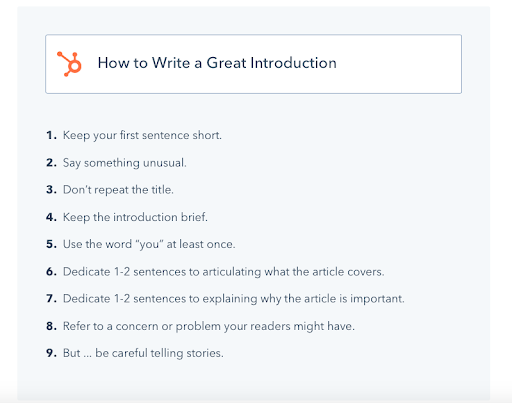
Better yet, make it clickable so people can skip to the section they want.
C. Create bulleted lists
Bullet lists help you present multiple points in an easy-scan way. Plus, they look different from the rest of your copy, which provides a visual break for your reader.
D. Use deep captions
Studies have shown that image captions are consistently some of the most-read copy on a page. So, consider using deep captions which are 2-3 sentences long.
E. Highlight the main points
Emphasise key points so the scanner can quickly pick them out. Use bold, highlights, CAPS, italics, or breakout boxes.
F. Write in short paragraph of 1-2 sentences.
This makes your copy easier to read, while also creating lots of white space.
Use different font sizes – people scan large text first.
7. Use the Four C’s
It’s easy as an SEO copywriter to get carried away once you start writing. So how do you keep your copy on track?
Use the Four Cs:
- Clear. Make your point really clear.
- Concise. Cut anything out of your content that doesn’t directly answer your reader’s problem.
- Compelling. Make it really interesting. Work in stats, quotes and anecdotes.
- Credible. Back it up with high quality sources and references.
All of this helps you create an incredible user experience with your copywriting.
HubSpot is excellent at putting this to work:

Let’s see how they tick the Four C’s:
- Clear. The headline and intro make the point clear from the outset.
- Concise. Everything in the article points back to the goal – providing tips to start a real estate business.
- Compelling. Stats, tips and quotes are used throughout the article to make it engaging.
- Credible. Stats are backed up with references and sources.
8. Use Bucket Brigades to Lead People Deeper
What are bucket brigades, you ask?
This is:
And then there’s this…
Confused?
Don’t be!
A bucket brigade is a ridiculously short phrase that breaks up the text and forces the reader to read on to get some context.
Here at OMG, we use bucket brigades A LOT.
Here are some you can use in your copywriting:
- Here’s what you need to know.
- That’s a fact!
- You’ll never believe why…
- Something like this:
As well as breaking up the text, bucket brigades force your reader to fall down your article until, before they know it, they’re at the end. Ultimately, they’re a tool to increase time on page and engagement, which are both metrics that Google pays attention to when ranking your content.
9. Edit, edit, edit
Now, you’ve finished writing your content, you’re done right?
No way!
The final step is to EDIT.
Editing is just as important as the copywriting.
True story!
Everything you write, whether it’s a social post, blog post or landing page, has a possibility of generating online business for you.
So, spend that final amount of time to get it right.
Look for these things:
- Throw out the points you don’t need.
- Correct any awkward or unclear sentences.
- Check for misspellings and typos.
- Make sure sentences aren’t too long – read it aloud. If you have to stop to breathe, it’s too long!
Here’s the challenge with editing. You can be too close to your copywriting to see any mistakes. That’s why it’s worth using an SEO plugin like Yoast, SEMrush or Grammarly.
These tools can check your copywriting for things like plagiarism, typos, grammar errors, long sentences, keyword density, and more.
Another really important step in the editing process?
Ask for feedback.
Find out what people love and hate about your copywriting – especially if the people fit your buyer persona.
10. Bring in humour
Want to engage your audience?
Make them laugh.
Remember how we said that SEO copywriting can sound robotic? Humour is a great way to counteract that and bring your copy to life.
Entertaining copy encourages your audience to keep reading. Plus, if you create content that people love, they’ll naturally start to trust your brand and your recommendations — which leads to higher conversion rates and brand loyalty.
Take a look at this web page by Frank Body:
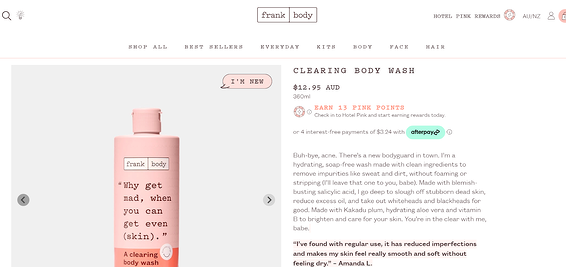
The thoroughly entertaining description encourages visitors to keep reading, while also communicating the benefits of the product.
Use Click to Tweet buttons
Sharable content is rankable content.
Social sharing buttons are a good start. But the best tactic for getting your audience to promote your content via social media marketing is the Click to Tweet button.
You’ve probably seen these before on websites like Content Marketing Institute:
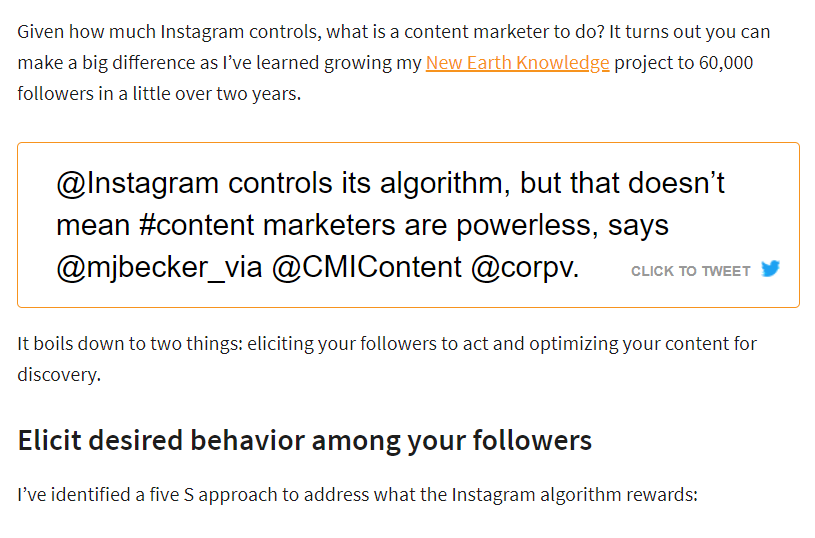
Image source: Content Marketing Institute
These buttons are incredibly helpful when it comes to encouraging readers to share — and they’re insanely easy to incorporate into your blog post.
Simply go to Click to Tweet (one of our favourite SEO copywriting tools). Click ‘basic link’ and then paste your content in:
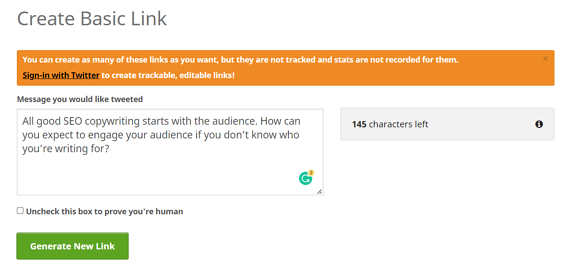
Hit ‘Generate New Link’ and you’ll get a link like so:

Add this link in your copy to give users an easy way of tweeting your content.
Try Click to tweet buttons for any actionable tips, useful statistics or impactful quotes. You’ll be surprised at how this simple action helps boost the sharability of your post.
Copywriting don’ts in 2022
On top of the tips we’ve shared above for SEO copywriting success, there are also a number of things you should avoid if you’re trying to optimise your copywriting for users and search engines. Follow these 6 tips to know which mistakes to avoid and give your content the best shot of ranking in organic search.
Don’t write for just Google
Let’s start with the biggest don’t for SEO copywriting: writing content for Google first, and readers second (or not at all).
Google’s algorithm is extremely sophisticated. Ever since the Panda update, Google has gotten A LOT better at recognising when web content is designed specifically for search engine optimisation — and it’s gotten stricter about how it penalises those websites. Not to mention, web users are savvier now than ever and can detect robotic-sounding SEO content from a mile away.
In 2022, you need to be writing for readers and Google. That means creating persuasive and informative high-quality content that provides value, while being optimised for specific keywords and on-page SEO considerations.
Don’t neglect on-page SEO when you write SEO copy
Writing for users doesn’t mean neglecting SEO considerations altogether.
You still need to structure your content in a way that search engines can understand. That gives it the best chance of ranking in search engine results and the featured snippet spot, while also generating more organic traffic to your page.
This means structuring your content with the <H1> heading tag and <H2>, <H3> and <H4> subheading tags, adding in meta tags for every web page, and incorporating internal and external links whenever appropriate.
Don’t use different spellings on the same page
During your keyword research, you might come across a search term that’s spelt differently. For example, if your focus keyword is “search engine optimisation”, you might see it spelt using British and American spelling.
Your first instinct might be to slip in the Americanised spelling in your copy. However, if the rest of your content is written in British English, this spelling sticks out like a sore thumb in Google’s eyes.
Stick to the correct spelling for the region your target audience is based in, even if you have to modify the spelling to ensure it makes sense for your readers.
Don’t go overboard with keywords
Keyword stuffing is an absolute no go when it comes to SEO copywriting. This is one of the most obvious signs for Google that your content has been written for search engines, not for readers — and if you do it frequently enough, it harms the user experience and your organic ranking.
According to Google’s Webmaster Guidelines:
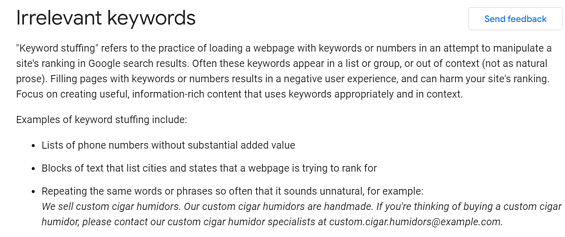
Add in targeted keywords whenever they make sense within the context of your copy, and try to keep your keyword frequency to roughly 1-2% of your total word count. If you’re not sure about a keyword, it’s better to leave it out or pop in the keyword somewhere else than to plug it in unnaturally in a sentence where it doesn’t belong.
Don’t ignore your URLs
A lot of marketers spend a ton of time optimising copy, and not a lot of time optimising their URLs.
Big mistake.
A study by Backlinko found that short, keyword-rich URLs tend to rank higher on Google AND get a higher CTR from users.
Don’t just leave your URL as a long headline or an auto-generated post number. Shorten it down to your target keyword — for example, the URL for this SEO copywriting is just:

Don’t just make it up as you go along
SEO copywriting should be part of a broader SEO strategy. If you’re just writing content and ignoring technical or off-page SEO, we guarantee you won’t get the results that you’re hoping for with search engine optimisation.
That is to say: all good SEO starts with a solid game plan.
Conduct an audit to identify where you currently stand and which keywords you want to rank for. Use this to guide your content creation efforts and monitor your results on a regular basis to see how you’re tracking. At the same time, you should be focusing on link building for domain authority with high-quality backlinks to your website, and tweaking your technical elements for crawlability and indexability.
When you put them all together, and your copywriting efforts will get discovered by your audience sooner.
Take your SEO copywriting to the next level
There you have it! All the SEO copywriting steps to get great search engine rankings and engage your target audience.
Use the tips and tools in this article to hone your copywriting mastery. These are the tips used by the best content writers around the world to create copy that Google and customers LOVE.
Good SEO copywriting is one of the fundamental skills you need to make your site rank higher and rake in revenue. You need it to craft landing pages that convert, ad copy that drives sales, and content that nurtures and drives your conversion rate sky-high.
Make SEO copywriting the cornerstone of your strategy. Download your free Digital Marketing Game Plan today.









